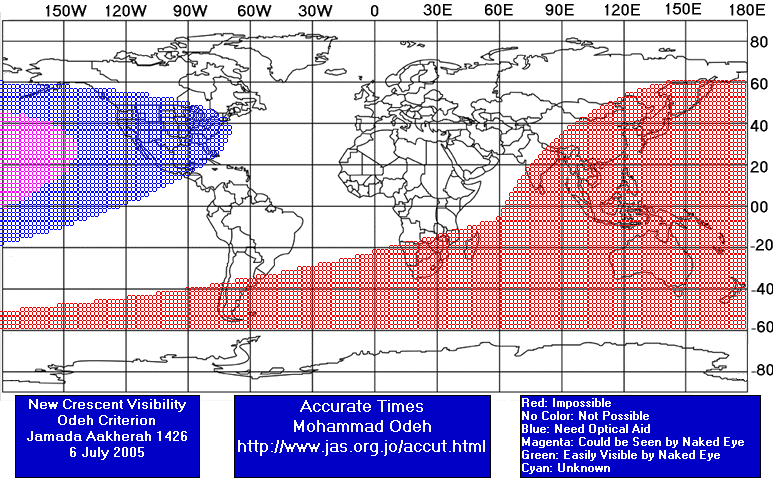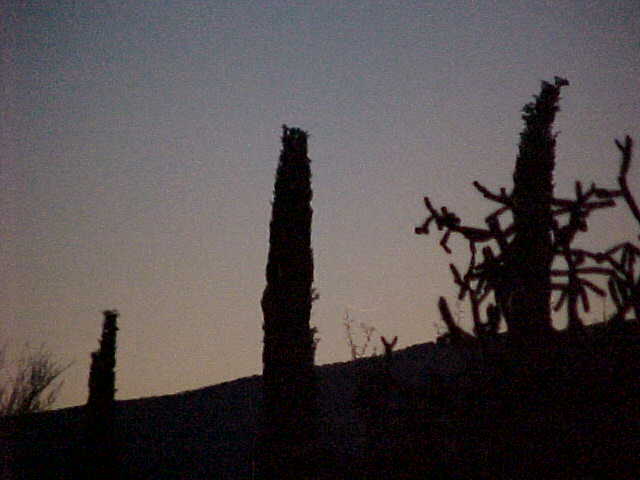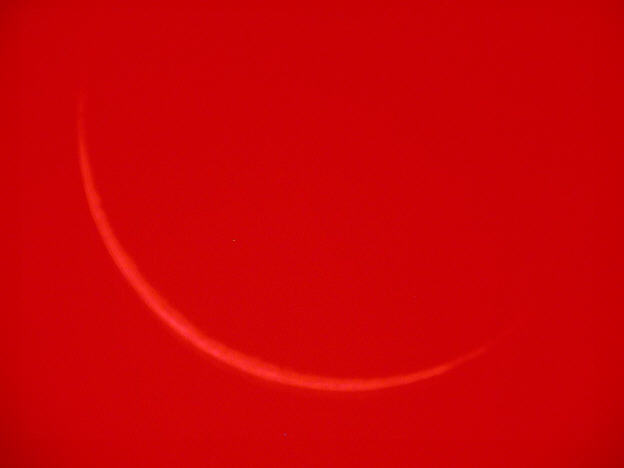Visibility of Jumadal Thani Crescent
(1426 AH)
- When to Observe Jumadal Awwal Waning (OLD) Crescent ?
- When to Observe Jumadal Thani Waxing (NEW) Crescent ?
- Jumadal Awwal Waning (OLD) Crescent Observation Results
- Jumadal Thani Waxing (NEW) Crescent Observation Results
- The OFFICIAL First Day in Different Countries
In Other Pages:-
- ICOP Main Page
- Members of ICOP (Individuals)
- Members of ICOP (Groups)
- Friends of ICOP
- ICOP Membership Application (For Individuals)
- ICOP Membership Application (For Groups)
- ICOP Observation Report Form
- ICOP Related Links
The geocentric conjunction (Geocentric New Moon) will occur Inshalla on (Wednesday 06 July 2005), at
12:02 UT. On this day, the program Accurate Times by Mohammad Odeh -according to Odeh criterion- showed that the OLD crescent should be seen by optical aid from some eastern parts of the world, while it is impossible or not possible to see the crescent from the rest of the world.
The geocentric conjunction (Geocentric New Moon) will occur Inshalla on (Wednesday 06 July 2005), at
12:02 UT. On this day, the program Accurate Times by Mohammad Odeh -according to Odeh criterion- showed that it is impossible to see the crescent from the eastern parts of the world, while it is not possible to be seen from most parts of the world, where as it should be visible by optical aid only from parts of North America continent.
According to the actual sighting of the crescent, the start of Jumadal Thani should be on
Friday 08 July 2005 in most parts of the world.
- Results of seeing the crescent, and the first day of the month in different countries will be added here Inshalla as we receive the reports from ICOP's members. If you wish to be a member in ICOP, or to know more about it, kindly click here.
Tuesday 05 July 2005:
So far, the earliest sighting of the crescent was on Thursday 07 July 2005 from Saudi by ICOP member Mr. Saleh Al-Saab.
Wednesday 06 July 2005:
Thursday 07 July 2005:
Thursday 07 July 2005 :-
Friday 08 July 2005 : -

When to Observe Jumadal Awwal Waning (OLD) Crescent ?


When to Observe Jumadal Thani Waxing (NEW) Crescent ?


Jumadal Awwal Waning (OLD) Crescent Observation Results
Location = Tucson, Arizona (USA)
Longitude = 110.9645 W
Latitude = 32.4204 N
Elevation = 842 meters
Time Zone = -7.0 hour
Surface conditions at time of sighting at
Tucson Airport:
Temperature = 25 degrees Celsius
Dew Point = 0.5 degrees Celsius
Atmospheric Pressure = 1009 mb
Crescent first observed through 9x63 binoculars:
Time = 04:50 LT
Altitude = 4 degrees (As soon as it rose over the ridge)
Crescent first observed with the naked eye:
No matter how hard I tried, even with trees framing the Moon, I could not see the crescent with naked eyes.
However, I am sure that others would have seen it easily.
Final observation with binoculars:
Time = 05:00 LT
Altitude = 6 degrees

Stamm added: "Apparently my 10x digital is better than my eye"
Jumadal Thani Waxing (NEW) Crescent Observation Results
Location = Tucson, Arizona (USA)
Longitude = 110.9645 W
Latitude = 32.4204 N
Elevation = 842 meters
Time Zone = -7.0 hour
Surface conditions at 19:55:
Tucson Airport:
Temperature = 99 degrees Fahrenheit
Dew Point = 34 degrees Fahrenheit
Atmospheric Pressure = 29.92 in. Hg
Topocentric and local time values from “Accurate Times”:
Sunset (at sea level) = 19:40
Moonset (at sea level) = 20:21
Time from new moon at 19:50 = 16hr. 10min.
Moon lag time = 42 minutes
Relative Altitude = 7.44 degrees
Elongation from sun = 7.52 degrees
Crescent width = 8 arcseconds
Illumination = .43 percent
I was NOT able to see the crescent, even through a telescope.
I had set my scope the night before, and after a couple of tweaks it was dead on the new Moon’s location for 19:40 Wednesday evening. Well, it was so clear and dry that I got anxious, and thought I might be able to see the crescent much earlier. So I used my daylight technique and searched in vain for a couple of hours. I discovered that my drive quit (overheated in the 108 degree temperature?), so I had to resort to scanning (focus was checked) all the way into a tree with no luck. We used the 9x63s to search during the last 15 minutes.
Observer(s): Jim Stamm; John Polacheck


The OFFICIAL First Day in Different Countries





